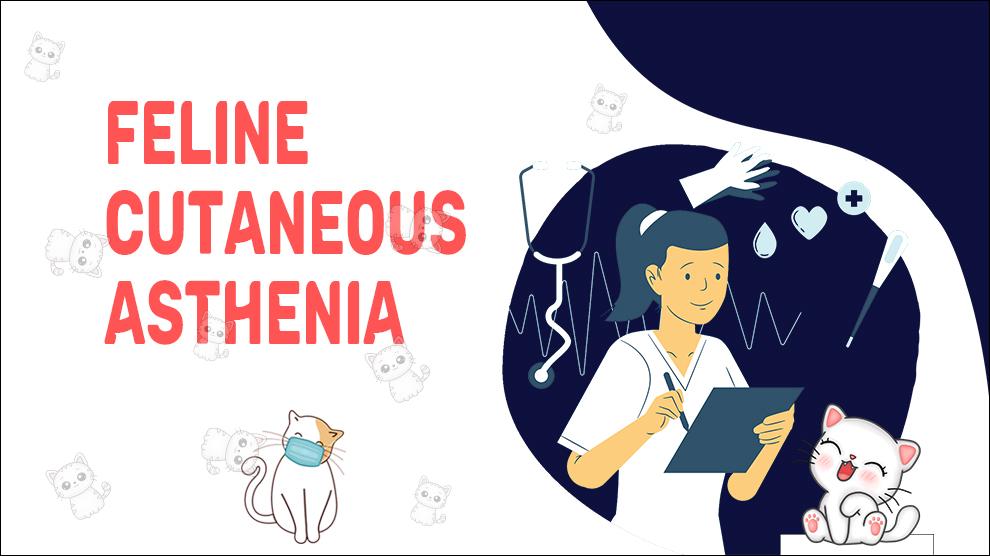What Is Feline Cutaneous Asthenia?
Feline Cutaneous Asthenia is a genetic condition that affects the connective tissues in cats, leading to fragile and easily damaged skin, hypermobility of the joints, and abnormal bleeding tendencies.
This condition is rare but has been identified in various cat breeds.
The severity of the symptoms varies from cat to cat, with some cats showing only mild symptoms, while others may experience life-threatening complications.
Clinical Signs Of Feline Cutaneous Asthenia
The most common symptom of Feline Cutaneous Asthenia is fragile skin that is easily torn or damaged.
The skin may also be hyperelastic, meaning it can be stretched beyond its normal limits. The skin may also be thin and have a wrinkled appearance.
Cats with Feline Cutaneous Asthenia may also have hypermobility of the joints, which can cause them to dislocate more easily.
The condition can also cause abnormal bleeding tendencies, which can lead to excessive bleeding from minor injuries or during surgery.
- Loss Of Skin Elasticity
- Skin Ulcer
- Skin Lesions
- Hair Loss
- Lack Of Appetite
- Sunken Eyes
- Pale Gums
- Vomiting
- Weight Loss
- Lethargy
- Weakness
- Dark Yellow Color Urine
- Yellow Eyes
- Yellow Skin
- Yellow Gums
- Deformed Bones
Treatment Options For Feline Cutaneous Asthenia
There is no cure for Feline Cutaneous Asthenia, and treatment focuses on managing the symptoms and preventing complications.
Cats with Feline Cutaneous Asthenia should be handled with care to avoid injuring their fragile skin or causing joint dislocations.
Wounds should be cleaned and treated promptly to prevent infection. In severe cases, surgery may be required to repair joint dislocations or wounds.
Home Remedies For Feline Cutaneous Asthenia
There are no home remedies for feline cutaneous asthenia. It is essential to take your cat to the veterinarian as soon as you suspect a problem.
The veterinarian will recommend the most effective treatment for your cat, which may include medication or surgery.
How To Prevent Feline Cutaneous Asthenia?
Since Feline Cutaneous Asthenia is a genetic condition, it is not preventable.
However, breeders can reduce the incidence of the condition by screening cats for the genetic mutation before breeding.
Cats that carry the mutated gene should not be used for breeding to avoid passing on the gene to their offspring.
It is essential to work with a reputable breeder who screens their breeding cats for genetic mutations.
Affected Cat Breeds Of Feline Cutaneous Asthenia
Feline cutaneous asthenia is a genetic condition and affects several cat breeds, including domestic shorthairs, Persians, Siamese, and Devon Rexes.
Causes For Feline Cutaneous Asthenia
Causes:
Feline Cutaneous Asthenia is caused by a genetic mutation that affects the production of collagen, the primary structural protein in connective tissues.
The genetic mutation affects the synthesis, secretion, and processing of collagen, leading to abnormalities in the structure and function of the connective tissues.
The condition is inherited in an autosomal dominant manner, meaning that cats with one copy of the mutated gene will develop the condition.
When To See A Vet For Feline Cutaneous Asthenia?
Cats with Feline Cutaneous Asthenia should be monitored closely for any signs of complications such as joint dislocations, abnormal bleeding, or skin infections.
If your cat develops any of these symptoms, you should take them to the vet immediately.
It is essential to handle cats with Feline Cutaneous Asthenia with care to avoid injuring their fragile skin or causing joint dislocations.
Regular veterinary check-ups are also essential to monitor your cat's overall health and detect any potential complications early.
Food Suggestions For Feline Cutaneous Asthenia
There is no specific diet for cats with feline cutaneous asthenia, but a balanced and healthy diet can help keep your cat's skin and coat in good condition.
Conclusion
Feline cutaneous asthenia is a rare genetic condition that affects the connective tissue in cats, causing the skin to become thin and fragile.
The condition can lead to skin tears and ruptures, as well as joint and muscle problems.
There is no cure for feline cutaneous asthenia, but treatment can help manage the symptoms and improve your cat's quality of life.
It is essential to take your cat to the veterinarian if you suspect a problem and follow their recommended treatment plan.
With proper care and management, cats with feline cutaneous asthenia can live happy and healthy lives.











